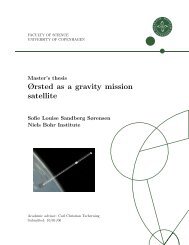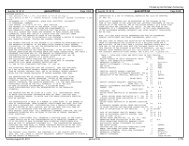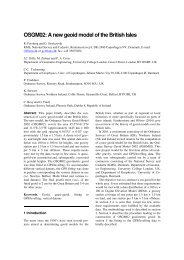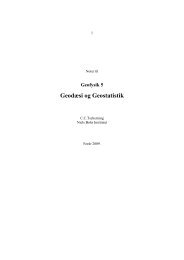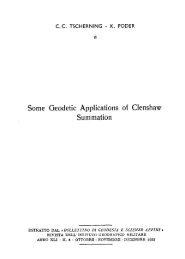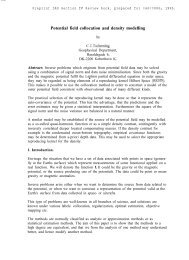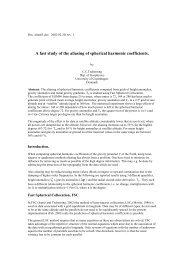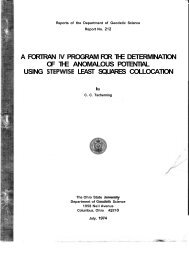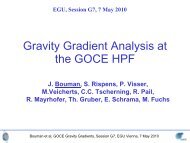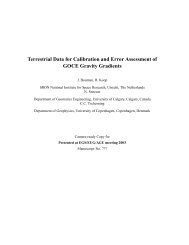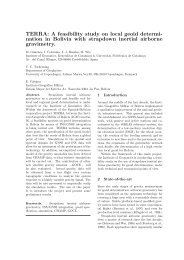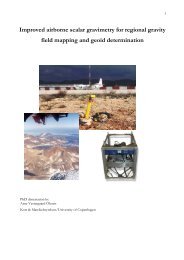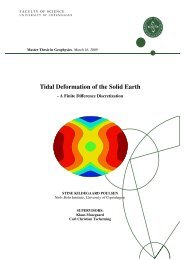Kaas. E., B. Sørensen, C. C. Tscherning, M. Veicherts Multi ...
Kaas. E., B. Sørensen, C. C. Tscherning, M. Veicherts Multi ...
Kaas. E., B. Sørensen, C. C. Tscherning, M. Veicherts Multi ...
Create successful ePaper yourself
Turn your PDF publications into a flip-book with our unique Google optimized e-Paper software.
Abstract<br />
<strong>Kaas</strong>. E., B. <strong>Sørensen</strong>, C. C. <strong>Tscherning</strong>, M. <strong>Veicherts</strong><br />
<strong>Multi</strong>-Processing Least Squares Collocation: Applications to Gravity Field Analysis.<br />
Draft 2013-04-03<br />
Least Squares Collocation (LSC) is used for the modeling of the gravity field, including prediction and error<br />
estimation of various quantities. The method requires that as many unknowns as number of data and<br />
parameters are solved for. Cholesky reduction must be used in a non-standard form due to missing positivedefiniteness<br />
of the equation system. Furthermore the error estimation produces a rectangular or triangular<br />
matrix which must be Cholesky reduced in the non-standard manner.<br />
LSC have the possibility to add new sets of data without reprocessing earlier reduced parts of the equation<br />
system. Due to these factors standard Cholesky reduction programs using multi-processing cannot easily be<br />
applied. We have therefore implemented the use of Fortran Open <strong>Multi</strong>-Processing (OpenMP) and Message<br />
Passing Interface (MPI) to the non-standard Cholesky reduction. In the computation of matrix elements<br />
(covariances) as well as the evaluation spherical harmonic series used in the remove/restore setting we also<br />
take advantage of multi-processing.<br />
We describe the implementation using quadratic blocks, which aids in reducing the data transport overhead.<br />
Timing results for different block sizes and number of equations is presented. Both OpenMP and MPI scales<br />
favorably so that e.g. the prediction and error estimation of grids from GOCE TRF-data and ground gravity<br />
data can be done in the less than two hours for a 25deg by 25deg area with data selected close to 0.125<br />
degree nodes. The results are obtained using a Dual Processor Intel(R) Xeon(R) CPU at 2.40GHz with a total<br />
of 24 threads.<br />
1. Introduction.<br />
LSC (Moritz, 1980, Torge and Müller, 2012) has been and is used for gravity field modeling. This includes<br />
the determination of parameters and the estimation of errors. The quantity to be modeled is the so-called<br />
anomalous potential T, which is a harmonic function outside the masses.<br />
The method requires that a number of equations equal to the number of data and of contingent parameters are<br />
solved for. This has forced the development of “fast” methods (e.g. Sansò and <strong>Tscherning</strong>, 2002) which<br />
require that data are interpolated to the nodes of a grid. However, the use of multiprocessing has changed the<br />
picture, so that it has become possible to use LSC using large (200000+) sets of data.<br />
The use of the method requires that a function space with a reproducing kernel is selected, so that the kernel<br />
approximates an empirical covariance function of T. This function is generally determined from gravity<br />
anomalies and approximated with a corresponding reproducing kernel. This assures the positive-definiteness<br />
of a part of the LSC equation system (see Appendix A). We will not discuss this here, but explain how<br />
multiprocessing has permitted us to overcome the limits posed by the number of equations to be solved.<br />
However, multiprocessing may also aid in other parts of the LSC process as discussed in the following.<br />
2. Remove-store procedure.<br />
In order to statistically homogenize T, to de-correlate data and to permit the use of spherical approximation<br />
in regional applications, the effect of a global Earth gravity model (EGM) can be subtracted and<br />
subsequently added. If we write the expression for such a model



